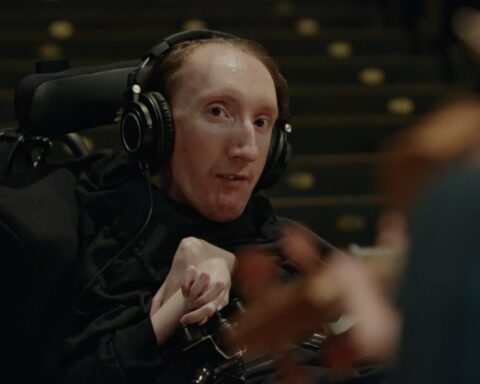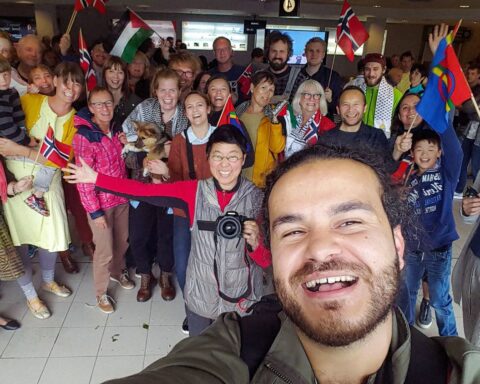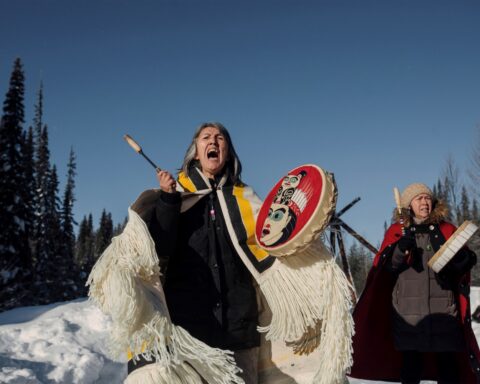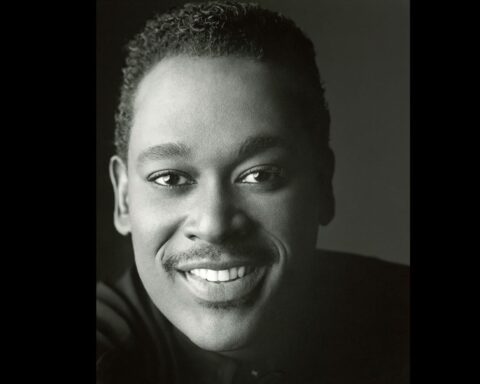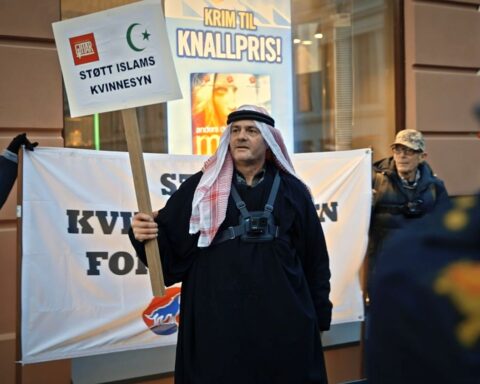It is always difficult, and indeed sometimes misguided, to try to date precisely the “birth” of a movement or an “era” in film history. However, there are certain films that stand out as undeniable turning points and can thus be singled out as marking a “beginning.” This is the case for Michel Brault and Gilles Groulx’s Les raquetteurs, a short documentary produced fifty years ago that heralded the emergence of Québécois cinema.
Michel Brault started working at the National Film Board of Canada (NFB) shortly after its move from Ottawa to Montreal in 1956. In fact, Brault had already worked at the NFB back in 1950, but left after a few months because of the wide spread “francophobic” attitude at the then largely unilingual Board. With the move to Montreal, the NFB became much more open to French Canadian culture, providing a space for a team of Quebec cineastes, an “Équipe française” as it were, to coalesce and develop a vibrant artistic community. Many members of “Équipe française” worked with Anglophone colleagues of Unit B on the creation of a series of short films made for television, the Candid Eye, thus titled to evoke the idea of a cinema that would unobtrusively observe the life of ordinary people. While a number of Unit B filmmakers were involved in the Candid Eye series, the leaders of the movement were Terence Macartney-Filgate, who brought some productive lunacy to the whole enterprise, and Wolf Koenig, a consummate cinematographer. Brault joined Macartney-Filgate, Koenig and a few others on the shoot of The Days Before Christmas in December 1957. Equipped with light Arriflex cameras and heavier Auricon cameras fitted with an integrated sound system capable of recording sound on a magnetic strip affixed to the film, the crew went looking for shots of children making their requests to various incarnations of Santa Claus, adults rushing around to do their last-minute shopping, and taxi drivers manoeuvring through the crowded, snowy streets of Montreal.
Most cameramen involved in the shoot were relying primarily on telephoto lenses to capture the pre-Christmas frenzy from a distance but Koenig broke the rules when he shot, from up close, a security agent escorting a bag of money from a store to an armoured truck. This shot has been interpreted as a clever commentary on the commercialization of the holidays. For Brault it was a veritable revelation, but not because of its metaphorical overtones. Rather, it was its revolutionary technique that amazed him. “Wolf Koenig took an Arriflex, with a wide-angle lens, placed it right behind the security guard’s gun — in close-up — and followed him as he left the store and walked to the armoured truck,” recalls Brault. “This was the first shot I ever saw where the cameraman didn’t frame the shot, but rather just held the camera at hip level. It is as though someone was finally showing me what to do. This was in 1957-58 and it was the first hand-held shot that truly impressed me. So I started hand-holding the camera all the time.”
Immediately after collaborating on The Days Before Christmas, Brault requested funds to make his own “Candid” film. In early 1958, he was given a budget of $7,000 to make a three-minute short for the Coup d’Oeil / Eye Witness series on a convention of snowshoers in Sherbrooke, south of Montreal. Brault recruited Marcel Carrière as his sound man, and asked Gilles Groulx, an editor who was reportedly bored to tears with his current project, to join him for a weekend of shooting in Sherbrooke. A few days and ten thousand feet of footage later, Brault returned to Montreal and showed the rushes to his boss, Grant McLean. Not impressed, McLean barked, “you can’t do anything with this. It’s just good for stock footage!”
Brault and Groulx ignored McLean and decided to edit the material secretly, after-hours. Eventually, producers Tom Daly, Louis Portugais and Guy Glover agreed to provide extra funding to allow Brault and Groulx to complete the film. Les raquetteurs, now fifteen minutes long rather than three, was shown to Mrs. Frances Flaherty, who happened to be in Montreal at the time. The widow of famous documentarian Robert Flaherty liked what she saw and invited Brault to show his short film at the 1959 Flaherty Seminar in California. This is where Brault met Jean Rouch, who was amazed by the French- Canadian cinematographer’s work and would later invite him to collaborate on Chronique d’un été (1961) in Paris.From that point on, Les raquetteurs became a model for filmmakers interested in the new documentary practice that would soon be known as “Direct Cinema.” By 1970, Les raquetteurs had already been canonized by critics like Dominique Noguez as marking the birth of modern Quebec cinema.12 But why should this short film on the rather lacklustre topic of snowshoeing be hailed as such a landmark in Quebec film history? First, the atmosphere of secrecy that surrounded the completion of the film against McLean’s orders endowed Les raquetteurs with great symbolic significance. Here were two French-Canadian filmmakers making a film about a typically French-Canadian pastime in defiance of anglophone authority. This gesture of civil disobedience inspired a number of francophone filmmakers at the NFB to make “subversive” films behind their producer’s back. The most famous example is Groulx’s Le chat dans le sac (1964), which was supposed to be a short documentary but was turned “clandestinely” into a fiction feature film. Gilles Carle’s La vie heureuse de Léopold Z. (1965) was produced under similar circumstances. According to Brault, starting with Les raquetteurs, the modus operandi of Quebec cinema became clandestineness. Even a few anglophone rebels eager to “stick it to the man” followed Brault and Groulx’s lead, Don Owen being the best- known example.
Beyond clandestineness, the reputation of Les raquetteurs also rests on two key factors: its technical achievements and its cultural import. Inspired by Koenig, Brault wholeheartedly adopted the wide- angle lens and perfected the art of hand-held camerawork. But rather than only tailing a security guard in one brief sequence, Brault endeavoured to follow everyone, all the time, to document their activities, their interactions and their lived experiences. As Gilles Marsolais writes, Brault “tried to capture the event from within, up close, by actually living the event.” The cineaste threw away the tripod and decided to walk with the camera on his shoulder and tag along with people as they participated in the parade and the snowshoeing races, or as they remained on the sidelines and observed. He ran with the runners; mingled with the bystanders, and threaded his way among the revellers at the party where the “snowshoeing queen” was crowned and kissed by none other than Maurice “Rocket” Richard himself. “Michel Brault is unique among cameramen,” wrote Michel Régner in 1961. “When he picks up his camera and gets going, you never know what he will be able to catch in a crowd, or in an empty street. He seeks out moments of visual poetry, and he can find them anywhere.”
It is this ability to capture “decisive moments,” as Brault walks along unassumingly with his camera, that so impressed Rouch when he first saw Les raquetteurs. “Brault is the best camera operator in the world,” he said in 1960. “He invented the ‘walking camera’.” Mario Ruspoli agrees: “Brault masterfully handles the camera. He becomes the camera. He can move forward, backwards, up and down, crawl on the ground while filming, or sit on the top of a car. With his technique, the camera becomes human.” Brault’s technical mastery in Les raquetteurs is all the more remarkable considering he was not using a light 16mm camera, but rather a heavy 35mm Arriflex.
One of the best-known shots in the film shows Sherbrooke’s mayor welcoming the president of the American Association of Snowshoers. As though Brault had managed to sneak unnoticed into the small group of dignitaries, he shoots the mayor’s speech, handshakes and joyful laughter from an intimate low angle. Shooting cultural phenomena — however mundane — from within as Brault does here would become central to most Quebec films ranging from Brault and Pierre Perrault’s Pour la suite du monde (1963) to Louis Saia’s Les Boys series (1997-2005). The camera seeks to integrate viewers in the space of the event — whether it is a snowshoeing competition, a whale hunting party or an amateur hockey game — as a means to insinuate that actors and viewers belong to the same cultural sphere. The scene is also important because it is the only moment in the entire film that includes synchronous sound — one can even see Marcel Carrière’s microphone in a few frames. For Brault this is the sole instance of “direct cinema” in the whole fifteen-minute short, since the defining characteristic of this documentary practice is synch sound. As Michel Marie writes, “ ‘direct cinema’ refers first and foremost to a technique of simultaneous sound and image recording.” So while Les raquetteurs is often hailed as the first masterpiece of direct cinema, it is not really an instance of this documentary mode, for there are merely seconds of synch sound in the whole production; and in fact the term “direct cinema” started being used with any degree of consistency only after 1963, when the lightweight Éclair camera started being used with the Nagra sound recording system. But Les raquetteurs came five years before this fortuitous marriage, when Brault had to make due with a heavy 35mm camera and Carrière could only use a clunky spring-wound Maihak tape recorder.
Historically, therefore, Les raquetteurs is a “Candid” film like The Days Before Christmas. But its visual style and its soundtrack are certainly in the “spirit” of direct cinema. More so than other Candid films, the visual style of Les raquetteurs “tries to stick as closely as possible to the events,” says Marsolais, “to the extent of participating in the action so as to reproduce as honestly as possible the ‘reality’ of the people and events being observed.” Other “Candid” films did not stick so closely to reality. In terms of the soundtrack, while most of it was manufactured during post- production, as was traditionally the case, it still sought to create the sense of immediacy or “directness” that would only be fully achieved a few years later. Rather than narration, Brault, Groulx and the NFB’s “magicians of sound illusion”fabricated a cacophony of dialogues, music, radio announcements, instructions given over a public address system and other diegetic sounds that imitate the fragmentary texture of reality. With this subterfuge, Les raquetteurs tried to give voice to the people of Quebec.
As Brault has observed, the implicit purpose of the film was to capture the rituals of a people. Talking specifically about the party scenes that close the film, he said, “we wanted to discover what incites people to go to Sherbrooke every year and let loose. . . we wanted to find the snowshoers’s Dionysus. . . to uncover the tragedy behind the folklore.”26 Rather than Dionysus, Bill Marshall, in his Quebec National Cinema (2001), uses the term “Carnivalesque” to describe the phenomena that Brault and Groulx record in their film. For Marshall, the demented harmonica player performing during the party, the fat man overwhelmed by rotund laughter during the mayor’s speech, the young woman who falls flat on her face during the race, the musicians, the dancers, the drunks and those who mock them are all aspects of the Bakhtinian festival that serves to liberate these people from the oppression of the conservative Maurice Duplessis government and anglophone domination, at least until the word “FIN” brings the carnival to a sobering end. For Brault and Groulx, such activities represented the core of Quebec culture and incarnated the distinct ethos of French Canada. For the next several years, Quebec cinema, both documentary and fiction, would pursue the ethnographic project initiated by Les raquetteurs.
While Les raquetteurs’ ethnography might have been more or less conscious on the part of the filmmakers, by 1960, Brault and his partners from “Équipe française” were already adopting more overtly conceptual frameworks to explore Quebec culture. Perhaps the best example of collective ethnographic cinema is 1961’s La lutte, which Brault co-directed with Claude Jutra, Marcel Carrière and Claude Fournier.
Virtually every available NFB cameraman, including Wolf Koenig, was hired to shoot wrestling matches at the Forum. They not only captured the fights themselves, as well as the post-fight locker-room tirades, but also and most importantly the reactions of the spectators who uninhibitedly praised their heroes (especially Édouard Carpentier) and screamed with hatred at the villains (especially the evil Russians). The realism of the images themselves is counterpointed by Jutra’s ironic montage that superimposes a Bach- Vivaldi harpsichord concerto to rhythmically-edited images of the pugilists and their fans. The name of Roland Barthes — who was in Montreal in 1961 to work with Hubert Aquin on Du sport et des hommes and whom Brault met— appears in the credits, although he was not directly involved in the shooting of the film. But while Barthes did not go to the Forum with camera in hand, he still contributed substantially to the documentary by providing the conceptual framework within which the film was developed. Perusing the chapter “Le Monde où l’on catche,” from Mythologies (1957), one can immediately see how Barthes’s ideas influenced Brault and his colleagues. Every one of Barthes’ notions, from the symbolism of the various “holds” to the Christian structure of the temporary defeat of Good against Evil followed by re-birth and the overwhelming victory of the former over the latter, appear in La lutte. Undoubtedly, the French-Canadian spectators shown in the film were as enraptured by the morality play that wrestlers enacted before them as the European counterparts that Barthes had observed.
However, what Barthes ignores, and which is central to La lutte, is the ethnicity of the hero. While the famous French critic remarks, in passing, that within the American context villains are always “Reds,”33 he does not comment on the origins of the heroes, probably because this detail is irrelevant in France. In Quebec, however, the hero’s ethnicity is essential to the process of identification of the spectators. The wrestler Édouard Carpentier, who always triumphs against the odds, incarnates the dream of every North American francophone, every “Français d’Amérique,” who is constantly struggling to survive but will triumph in the end — or so wishful thinking goes. Wrestling at the Montreal Forum on Wednesdays is not only about the victory of Good over Evil, it is about the assertion that the victorious Good will be francophone. This is a most powerful national myth. It might be only a slight exaggeration to say that every single French-language film produced in Quebec since the days of direct cinema has been concerned at some level with this struggle of francophones to assert their existence against all odds.




